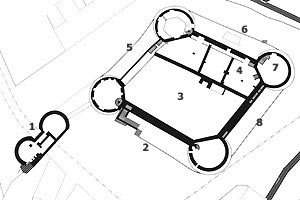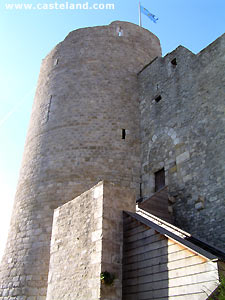

Cher |
Eure & Loir |
Indre |
Indre & Loire |
Loir & Cher |
Loiret |
Other regions & other castles |
Previous months’ selections |
| Castle of Yevre le Châtel |
|
|
1 - Castelet This strengthened door defends the entry of the "Low court" in which the population could take refuge. The small lords of the surroundings had their house there. A monastery was installed there. To reach it, one crossed the ditch on a opening bridge. 2 - The Access east
3 - High court Its level was definitely lower. The Western half was occupied by housing of the garrison. 4 - The home In each part the traces of the chimneys remain. The Western Northern room, as well as the following ones besides, was crossed by two arcs which supported the beams of the floor of the higher stage. Notice the beautiful columns with the carved capitals on which these arcs were pressed. 5 - Southern Face It is here that one sees best the ditch. It did not contain water but separated the artificial hillock (mound) from the plate. II was dug to pile up the ground in the medium and to create a dominant position. Thus, the height of the walls was increased. 6 - Western Face An old drawing shows a tower separate of the castle, and connected by a footbridge which one sees the departure under the windows. Those Ci make it possible to light the home. 7 - Western Northern Turn The vaults are supported by intersecting ribs. The staircase is spared in 1 thickness of the wall, with openings which make it possible to supervise each room and, if need be, to shoot at the attacker. Notice the firing angles of the loopholes. 8 - Northern Face one sees to 6 m of the ground the second exit of the castle. II also an underground on this side had there. |
|
Castle of the month : |
Search |
For any question concerning this Web site, send a message to webmaster


 The
pile, opposite the door, thanks to a mobile footbridge, made it
possible to reach the high court. To enter, one passes under a "pole-axe"
the soldiers who were on the courtine could make fall from the stones
on those which were presented. There were then a harrow and a door
with two casements which was blocked by two bars of reinforcement:
one was installation by inserting it, the other while turning it.
The turns are very projecting. The base broader (glacis) and is
built out of larger and well installed stones. Inside, it is a full
slope. Notice the loopholes along the wall: it is an unusual provision,
intended to prevent the enemy from approaching the walls. Notice
the arc which goes from the base of a tower to the other. It is
a relieving arch used speak Byzantine as of the Life century which
supports the wall (courtine); if the attacker digs a gallery (sap)
under the wall, that Ci does not break down. At the beginning of
XIIIe, it is an innovation for the Occident, brought back Crusades
under Philippe Auguste.
The
pile, opposite the door, thanks to a mobile footbridge, made it
possible to reach the high court. To enter, one passes under a "pole-axe"
the soldiers who were on the courtine could make fall from the stones
on those which were presented. There were then a harrow and a door
with two casements which was blocked by two bars of reinforcement:
one was installation by inserting it, the other while turning it.
The turns are very projecting. The base broader (glacis) and is
built out of larger and well installed stones. Inside, it is a full
slope. Notice the loopholes along the wall: it is an unusual provision,
intended to prevent the enemy from approaching the walls. Notice
the arc which goes from the base of a tower to the other. It is
a relieving arch used speak Byzantine as of the Life century which
supports the wall (courtine); if the attacker digs a gallery (sap)
under the wall, that Ci does not break down. At the beginning of
XIIIe, it is an innovation for the Occident, brought back Crusades
under Philippe Auguste.

